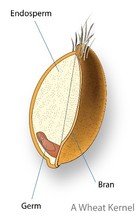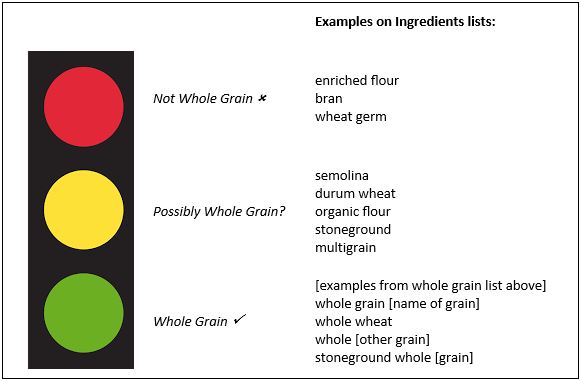Image may be NSFW.
Clik here to view.
Mike Seward, AB
Clik here to view.

Mike Seward, AB
In our traffic-light food labeling study at Harvard dining halls, recently published in the American Journal of Public Health, I used several nutrition criteria to label foods as “green”, or most nutrient rich; “yellow”, or nutrient neutral; and “red", or least nutrient rich. The most challenging criteria to assess were “Whole Grain” vs. “Refined Starch,” and with the public’s general fear of all things carbohydrate, it’s important to know the difference between types of carbs. But since whole grains account for only 10-15% of grains available for sale in supermarkets, how do we find them? After labeling hundreds of foods and beverages, here’s what I learned.
First, what is a whole grain?
Although refined starches are ubiquitous in supermarkets and are almost always the default choice in restaurants (oh, you want brown rice? That’ll be a $1.50 extra), every grain starts out “whole.” Whole grains contain all of the naturally-occurring parts of the grain: the bran, endosperm, and germ. Refined starches have the healthy germ and bran removed in order to prolong shelf life. Unfortunately, this processing also removes fiber, iron, vitamins, and almost all of the nutritional value in grains.
Why should I care about whole grains?
Higher whole grain consumption is associated with lower total mortality and lower risk of cardiovascular disease and cancer mortality. Diets high in whole grains can help maintain steady blood sugar, lower cholesterol, may lower the risk of heart attacks and strokes, and may protect against some cancers.
Examples
Here’s a quick list of whole grains provided by the Whole Grains Council, with some of my favorites in bold:
The Whole Grains Council lists how whole grains and refined starches appear on ingredient lists, which I shortened to some of the most common ingredients:
Although refined starches are ubiquitous in supermarkets and are almost always the default choice in restaurants (oh, you want brown rice? That’ll be a $1.50 extra), every grain starts out “whole.” Whole grains contain all of the naturally-occurring parts of the grain: the bran, endosperm, and germ. Refined starches have the healthy germ and bran removed in order to prolong shelf life. Unfortunately, this processing also removes fiber, iron, vitamins, and almost all of the nutritional value in grains.
Why should I care about whole grains?
Higher whole grain consumption is associated with lower total mortality and lower risk of cardiovascular disease and cancer mortality. Diets high in whole grains can help maintain steady blood sugar, lower cholesterol, may lower the risk of heart attacks and strokes, and may protect against some cancers.
Examples
Here’s a quick list of whole grains provided by the Whole Grains Council, with some of my favorites in bold:
- Amaranth
- Barley
- Buckwheat
- Corn, whole cornmeal, and popcorn
- Millet
- Oats (steel-cut oatmeal)
- Quinoa
- Brown rice
- Rye
- Sorghum (milo)
- Teff
- Triticale
- Wheat, including spelt, emmer, farro, einkorn bulgur, cracked wheat and wheatberries
- Wild rice
The Whole Grains Council lists how whole grains and refined starches appear on ingredient lists, which I shortened to some of the most common ingredients:
”Made with whole grain” isn’t the whole picture
Don’t be fooled by packages that advertise “baked with whole wheat.” As I outlined in my previous post on added sugar, food manufacturers can hide the amount of sugar in a product by adding multiple forms of sugar with different names. The same can be done with flour. A product could be made with 1% whole grain flour and 99% refined flour, and can still proudly claim to be “made with whole grain” on the packaging. Similarly, “multigrain” on a label doesn’t automatically make a product healthy; it just means it contains a combination of several grains, none of which may be whole grain.
Don’t Rely on the Whole Grain Stamp!
Unfortunately, not even the Whole Grain stamp is reliable -- that’d be too easy! A study at the Harvard T.H. Chan School of Public Health found that foods with “Whole Grain” stamps were higher in sugar and calories than whole grain foods without the stamp. Instead, the study found that the ratio of total carbohydrate to fiber identifies the healthiest whole grains:
Don’t be fooled by packages that advertise “baked with whole wheat.” As I outlined in my previous post on added sugar, food manufacturers can hide the amount of sugar in a product by adding multiple forms of sugar with different names. The same can be done with flour. A product could be made with 1% whole grain flour and 99% refined flour, and can still proudly claim to be “made with whole grain” on the packaging. Similarly, “multigrain” on a label doesn’t automatically make a product healthy; it just means it contains a combination of several grains, none of which may be whole grain.
Don’t Rely on the Whole Grain Stamp!
Unfortunately, not even the Whole Grain stamp is reliable -- that’d be too easy! A study at the Harvard T.H. Chan School of Public Health found that foods with “Whole Grain” stamps were higher in sugar and calories than whole grain foods without the stamp. Instead, the study found that the ratio of total carbohydrate to fiber identifies the healthiest whole grains:
So when you’re shopping:
Contrary to popular belief (and the restaurant brown rice surcharge), the same study found that products sold in major grocery stores with the “Whole Grain” Stamp were just 4 cents more expensive than non-whole grain products. So don’t let the price or tricky labeling get in your way.
If you liked this guide, check out my posts on added sugar, 60 Ways the Food Industry Hides Added Sugar and How to Limit Added Sugar, Not Taste.
- First look for products that have just one whole grain ingredient (e.g. brown rice).
- If multiple ingredients or grains are present, or if you see one of the “possibly whole grain?” ingredients from above, use the carb/fiber ratio to quickly identify the healthiest choices.
Contrary to popular belief (and the restaurant brown rice surcharge), the same study found that products sold in major grocery stores with the “Whole Grain” Stamp were just 4 cents more expensive than non-whole grain products. So don’t let the price or tricky labeling get in your way.
If you liked this guide, check out my posts on added sugar, 60 Ways the Food Industry Hides Added Sugar and How to Limit Added Sugar, Not Taste.


